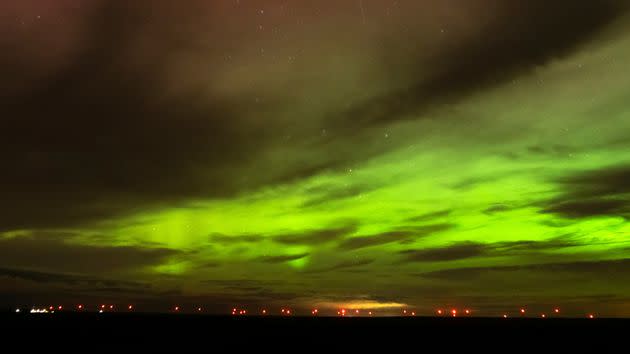Northern Lights May Be Visible In Multiple U.S. States This Week

An aurora borealis, also known as the northern lights, is seen in the night sky in the early morning hours of April 24, near Washtucna, Washington.
The northern lights may be viewable in more than a dozen U.S. states this week due to a large forecasted solar storm.
The Geophysical Institute at the University of Alaska Fairbanks predicts that the spectacle will be viewable in 17 states — including Alaska, Washington, Oregon, Idaho, Montana, Wyoming, North Dakota, South Dakota, Minnesota, Wisconsin, Michigan, Indiana, New York, Vermont, New Hampshire, Maine and Maryland — on Thursday. Parts of Canada will also be able to view the phenomenon.
They’re best viewed at night, during clear weather, between 10 p.m. and 2 a.m. local time, and away from the lights of a city, according to the NOAA Space Weather Prediction Center.
The lights, also known as aurora borealis, are visible up to 600 miles away, according to the National Oceanic and Atmospheric Administration’s Space Weather Prediction Center.
As such, viewers in or near areas such as Salem, Oregon; Boise, Idaho; Cheyenne, Wyoming; Annapolis, Maryland; and Indianapolis, Indiana may catch a glimpse “low on the horizon” rather than directly overhead, per the Geophysical Institute.
They will be visible from directly above Helena, Montana; Minneapolis, Minnesota; Milwaukee, Wisconsin; Bay City, Michigan; and several parts of Canada.
“Aurora is the name given to the glow or light produced when electrons from space flow down Earth’s magnetic field and collide with atoms and molecules of the upper atmosphere in a ring or oval centered on the magnetic pole of Earth,” the NOAA website says. “The collisions produce light much like how electrons flowing through gas in a neon light collide with neon and other gases to produce different colored light bulbs.”
The lights are most often visible in places like Alaska, Canada and some Scandinavian countries.
“During very large auroral events, the aurora may be seen throughout the U.S. and Europe, but these events are rare,” the Geophysical Institute’s website reads. The Institute said that sunspot activity, which leads to auroral activity, peaks every 11 years and is expected to do so in 2025.
The lights were last visible in the U.S. in April across 30 states following a solar flare that erupted on the sun, according to USA Today.
